Hello my dears! Welcome to another blog about my random nature exploration. Haha.
After my Avocado seed experiment, I looked into palm nuts this month because look at that! Look at how red they are even on a gloomy day! 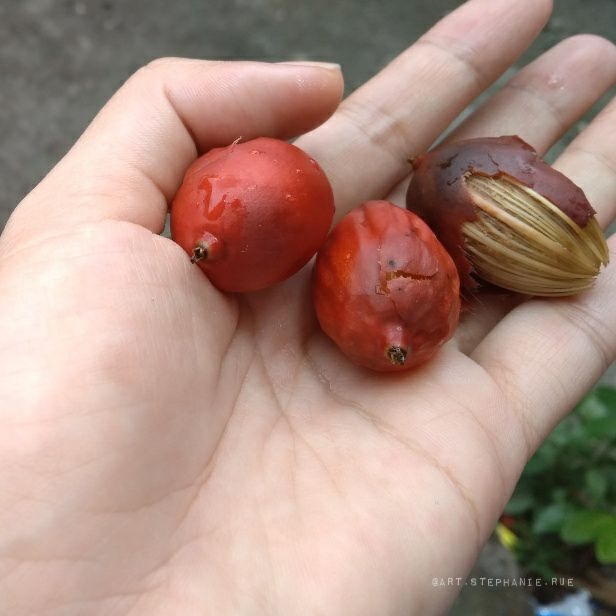
(Photo credit: ArtGirl via Bitlanders)
Wouldn't you be curious to know what it really is if you have plenty of time? Well anyway, I already did it for you so just read along and find out more. :)
Before I got a writing commission and became busy making three articles, I went to the backyard of our apartment and lo and behold, I saw these red things scattered outside.
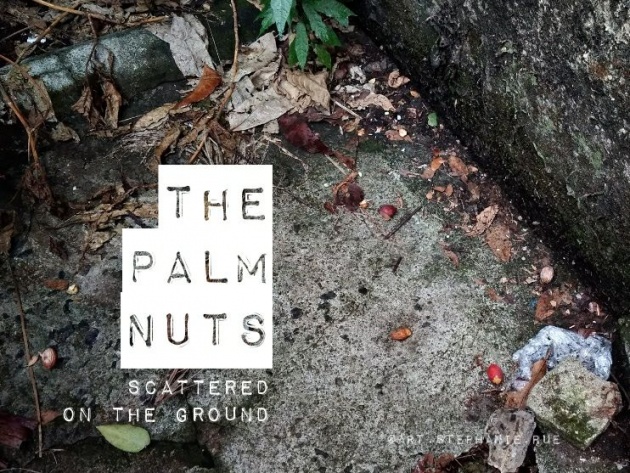 (Photo credit: ArtGirl via Bitlanders)
(Photo credit: ArtGirl via Bitlanders)
We had tropical depression Domeng causing torrential rains and then it became a storm. Now there's Ester coming in so it's been gloomy for days. It's been raining sporadically and heavily for more than a week now so I've been staying indoors more than usual. This is the reason why I got curious to find out what kind of palm tree these are from.
♣ Me and the Palm Trees ♣
When I came back from a weekend beach getaway in April and looked at my photos, I wondered what palm trees they were because they seem to be all over the Philippines! A simple search online didn't let me discover what it is because I don't know anything about palm trees. Due to curiosity, I decided to do more research.
Having free time and traveling to different places can definitely make you notice a lot of things you normally wouldn't. Most of the time, staying at home or working all the time will keep us from stopping to smell the roses. I mean, look at this picture. Don't focus on the sky and the mountain range or the beach and the tents so the palm trees will stand out.
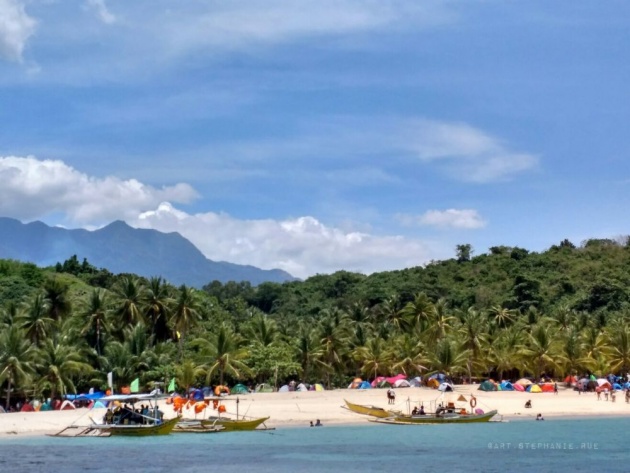 (Photo credit: ArtGirl via Bitlanders)
(Photo credit: ArtGirl via Bitlanders)
I don't think those are coconut trees as there weren't any fruits hanging but I am no expert. I'd need to go back there if I want to be sure. :P But wait, we have a palm tree in our apartment back yard! Lol.
Look at the picture below. It's so tall, almost level with our four storey apartment building. Seems like it has the same height as the ones at Laki beach. Those plants were really tall too.
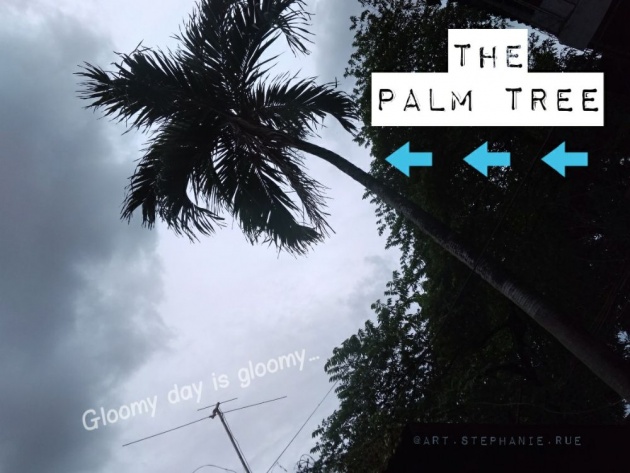
(Photo credit: ArtGirl via Bitlanders)
♣ The Quest for the Right Palm Tree Species ♣
I'm not a botanist or scientist so I don't know anything about palm trees. I only know the coconut tree when I see the fruits and that's it. Now that I have the time, I finally can share with you more info on these palm trees.
Based on the seeds I gathered, and upon checking lots of pictures online, I concluded all three are from the same species we Filipinos are also familiar with. The Betel nut is something our ancestors and provincial elders chew together with some lime and Betel leaf. It is said this is how our rural elders have strong and cavity-free teeth.
On Wikipedia it shows the following info:
The Arecaceae are a botanical family of perennial climbers, shrubs, acaules and trees commonly known as palm trees (owing to historical usage, the family is alternatively called Palmae). They are flowering plants, a family in the monocot order Arecales. Currently 181 genera with around 2600 species are known, most of them restricted to tropical and subtropical climates
So since the Philippines is a tropical country, I'm not surprised we have plenty of palm trees. Almost all palm trees look the same to me though. Haha.
On my quest to find out what tree or seeds I got are, I had to do several trial and error searches online. Who knew there are thousands of palm tree species all over the world? I found out there are various palm tree species in the Philippines too! Did you know some Filipinos even buy palm seeds from overseas when we have them here in the Philippines? Whoa. Maybe we should all sell some of these too?! Wait, I am getting ahead of myself.
Palm trees can either be agricultural or ornamental. This tree is definitely the latter. At first I thought it was a Foxtail Palm because of the same fruit coloring. After comparing online images, videos and descriptions though, the fruits proved to be different.
Eventually I found out which family the nuts belong to. Are you ready to find out what the seeds are??? Drum roll please.
As it turns out, these monocotyledon seeds are from a native Philippine palm tree! Can you believe it? Let me quote my discovery for emphasis. Haha.
Its scientific name is Adonidia merrillii (a.k.a. Veitchia merrillii) but it is more commonly known as the Christmas Palm! (That sounds way better than just Manila Palm or Dwarf Royal Palm, some of it's known names.)
The scientific term was derived from the ancient Greek name of Adonis (a beautiful man) and Elmer D. Merrill (1876-1956), an American botanist and scholar of the Philippine flora. It bears fruits in December thus people call it the Christmas Palm. Not only does the plant produce seeds in the cold months, it can also do so during summer.
In 1998 it was classified as a near threatened species! Seriously? Now I'm thinking I might not have the right tree if that's the case. Upon further checking on the term, it means this is at low risk so I think we need not worry yet. It seems abundant here in the Philippines you know. The IUCN Red List of Threatened Species does say the data needs updating so I don't know if it's already past being near threatened or not.
This plant variety actually got to Florida, USA too. Watch this video.
(Video credit: The Palm Fiend via YouTube)
Anyway, I even found and checked on an old book on Philippine palms. Am not sure if I understood all the scientific terms correctly but it looks like the right tree to me. I might be wrong (but I think I'm right!) with my classification so in case an expert sees this and wants to let us know, you can join us here and comment away!
As for the usage, these really only serve as decoration aside from giving ample shade. You know, like plant it along the sidewalk or something. Decorative palms are all over the world, even in Hollywood, California.
These trees are not safe from pests even if they serve as environmental decoration. I've seen one or two beetles around but not much so maybe the tree outside is healthy? Oh but the trunk shows some big holes. Hmmm. It probably got damaged by kids or eaten up like the plants in this video. Don't watch it if you don't like worms. :P
(Video credit: Deep Look via YouTube)
♣ The Palm Nuts Examination ♣
In order to truly find out the palm variety, this is what I did. Let's look closely at the seeds shall we?
Since most city folks don't bother much when we see palm trees every day because we're busy making a living, I'll happily look into it for you. Hahaha. I have enough free time when not working so here's what the backyard palm nuts look like.
I took 3 nuts from all the scattered ones outside after a night of heavy rain. One was almost dried up, another is semi-dry and the last is kind of a "just dropped" seed.
Let's examine the almost dry one first. I went ahead and removed half of the red covering and found some ants and a bit of pulp still there so I washed everything off. When I tried slicing it, the thick fibers or the husk kept me from doing it well so I had to remove it.
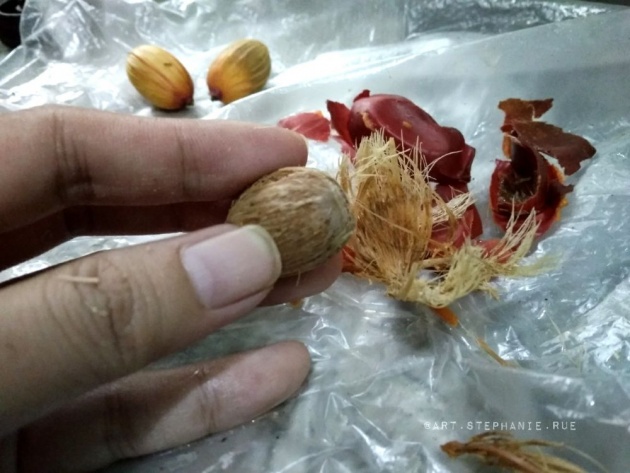
(Photo credit: ArtGirl via Bitlanders)
At this point I felt my fingers were a little greasy but not that noticeable. It's not that oily at all and maybe felt like if I put too little moisturizer on my skin. Anyway I used a small kitchen knife to saw through the seed. It's hard to hold on to a small slippery tough thing while being cut open so I didn't slice it. I sawed it partly because the coating is hard like a shell. As soon as the blade was in, I tapped the nut over our old unused wood chopping board and voila! It split open!
Now of course if you've been checking my galleries you would have already seen this. If not, check it out.
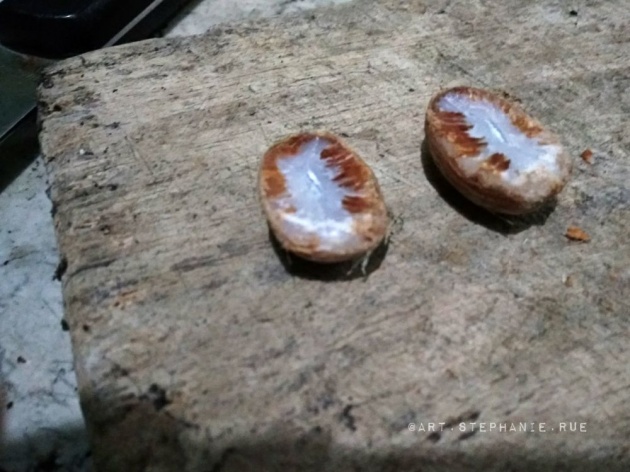 (Photo credit: ArtGirl via Bitlanders)
(Photo credit: ArtGirl via Bitlanders)
Isn't it a beauty? Since this is the drier one, I wanted to know if the rest looked the same. I peeled the other seeds to check. The other two were freshly fallen from the tree since they had more pulp as shown below. Actually the rest of that have already been removed when I thought of taking a picture. Hehe.
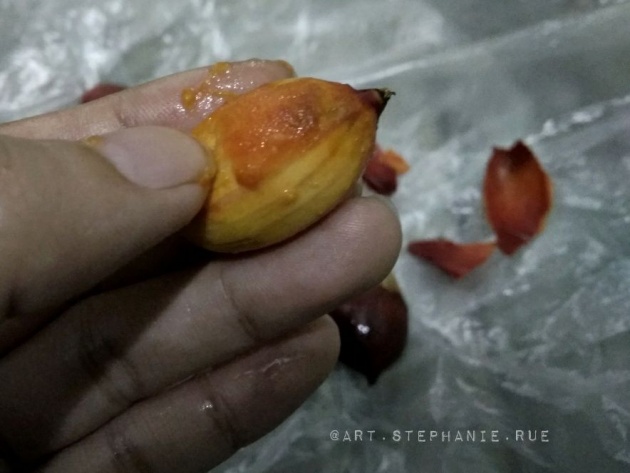 (Photo credit: ArtGirl via Bitlanders)
(Photo credit: ArtGirl via Bitlanders)
Think it's delicious? Sorry but no. Haha. Yes, I tasted it. Why not when I had the opportunity? I didn't roll it in my mouth or anything, just pressed the tip of my tongue on top of the fleshy part and then I spit. This is why I can't exactly say what it tastes like. It is not sweet, sour, salty or anything at all. It's almost tasteless but it's not. I don't know how else to describe it.
Here's the side by side comparison of the seeds. You will see the drier and "older" one on the left.
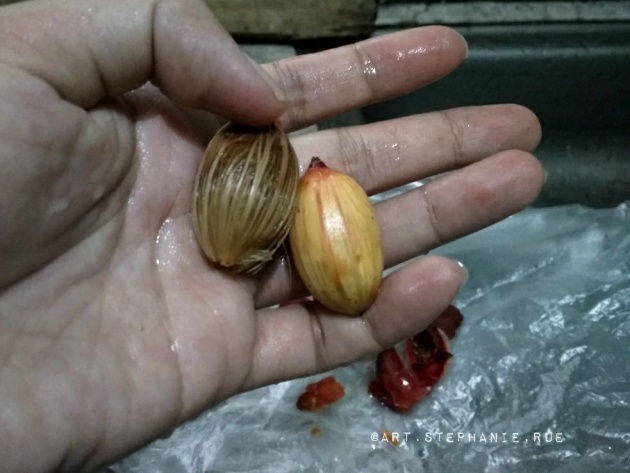
(Photo credit: ArtGirl via Bitlanders)
This is how the freshest seed looks like when cut open. I didn't think of cutting the last one crosswise though because I got dazzled by how pretty it was. The inside of the nut looks Christmassy to me too. ♥
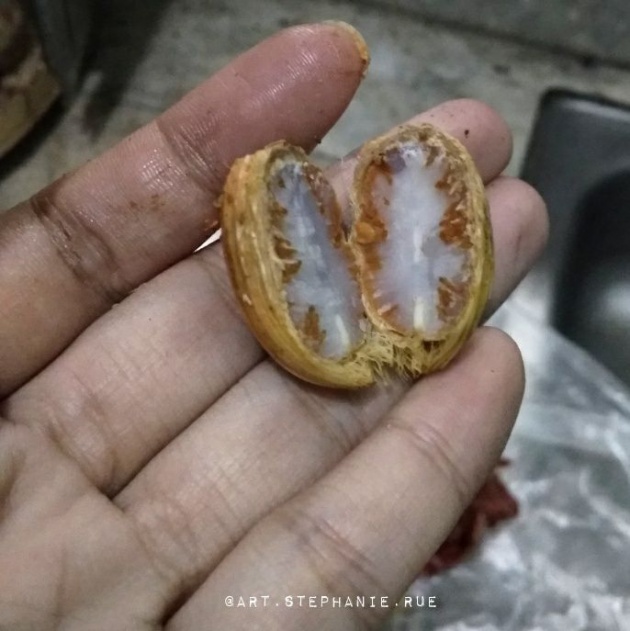
(Photo credit: ArtGirl via Bitlanders)
You might be asking, what does that white thing taste like? Well, after carving some out, I can say it tastes like dried coconut. It's crunchy and fiber rich that's for sure. I tasted both seeds and found no difference at all. It's like what you can expect when you leave a pan de coco filling out somewhere to dry. It's not sweet though, just "coconutty."
Is it edible and should we eat it? Well, as far as I know it's not eaten here in the Philippines, only chewed. Yes I also chewed half of one after removing the hard coating. Guess what happened? Oh, did my saliva come out real fast while chewing. Haha. It's mapakla (acrid?), similar to the taste you get from unripe bananas. There are no lime and betel leaf around me so maybe I should buy a real mix in the province to truly try the nganga experience.
In the Philippines, these seeds are called Bunga de Jolo, Bunga de Tsina or Bungang Tsina and serves as substitute for Betel (Areca) nut chewing in some areas.
I didn't notice the bitterness as much as I tasted the pakla. All I did was chew the half seed completely for 5 minutes, with periodic spitting too. Hahaha. After that I spit the resulting tiny chunks from my mouth and that was it.
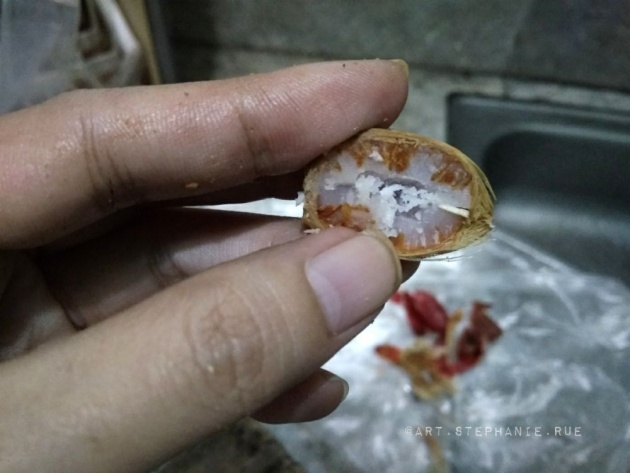
(Photo credit: ArtGirl via Bitlanders)
So to answer the above question, it would be a no, these palm seeds are not edible. If our ancestors didn't think it's good to eat then I see no reason for us to do so as well. I'm sure since they've been chewing this for centuries they know it is not something to swallow.
♣ What To Do With Christmas Palm Seeds ♣
Well, since these cannot be eaten or used for oil production, if you need some decorative plant let me know. I can sell it to you if you don't have any in your area.
I also noticed there are some growing Manila Palm tree seedlings beside the parent tree. Oh no. Want to buy it? It's about more than 2 ft already. Would have to be potted first though. Hmmm.
Then again maybe I'll let you know in December when seeds become available. In case you're looking for some right now, there are several reputable seed sellers online like rarepalmseeds. You can buy packs or samplers too.
If you'd like to grow these indoors, do a quick search online to learn eco-gardening, purchase and read e-books or join forums about it. Some videos can help out as well so you can grow this variety among other house plants. :) These can easily grow into lovely palm trees everyone would appreciate. Who wouldn't like a nice tropical shade from the harsh sun eh?
The Manila Palm variety is excellent for landscaping purposes and interior design. Full-grown height can depend on the care you provide it. Adult trees can grow up to 20 to 25 feet. Outside the forest and beaches, these are usually seen lining streets or brightening up cafes, malls or homes.
Plants make us city folks happier so growing and having these around would be fun and helpful too.
* * * * * * * * * *
Everything I learned brings the Christmas palm tree to a whole new level in my eyes. How about you? What do you think about it now?
For more of my environmental or nature related blogs, click below:
- The Most Exciting and Other Effective Ways to Get Rid of House Roaches
- Avocado Seed: Should You Eat It or Not?
- Oil Cleansing is a Gentler Facial Alternative >>> 5 star blog!
- The Importance of Sea Cucumbers
If you're not a Bitlanders member yet, sign up and click here
and be appreciated for what you post plus earn extra $$$.
To know more about this site and if you have any problem or site issues,
read the FAQ then please report and send an email to cs[at]@bitlanders[dot]com.
All images are copyright of their respective owners.
Written for Bitlanders by ArtGirl. All rights reserved
© Art x Stephanie Rue



